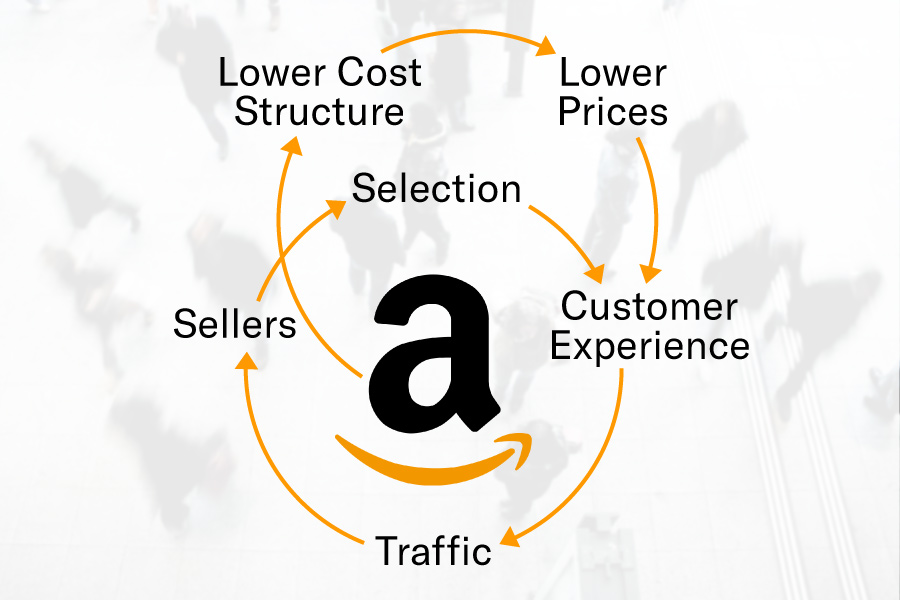The Amazon Flywheel
Shubhi Jain


Introduction
Amazon’s monumental success in e-commerce isn’t due to a single factor. It’s not just about having an extensive product range, competitive prices, or lightning-fast delivery. Instead, it’s a carefully crafted system where improvements in one area drive progress in others.
This self-reinforcing system is known as the Amazon Flywheel, a concept devised by Jeff Bezos and his team. It represents a cycle of growth where every positive change enhances other parts of the business, creating unstoppable momentum. But what exactly is the Flywheel, and why is it such a game-changer? Let’s break it down.
What is the Amazon Flywheel?
The Amazon Flywheel operates like a spinning wheel gaining speed. It relies on the principle that small improvements in one area spark a chain reaction across the entire business. For example:
Better shopping experiences attract more customers.
Increased customer traffic leads to higher sales and seller interest.
More sellers provide broader product choices, competitive pricing, and faster delivery.
Each of these factors reinforces the others, creating a self-sustaining loop that drives Amazon’s growth. This interconnected system allows the company to amplify results over time.
Breaking Down the Flywheel Components
1. Traffic: The Fuel for Growth
Traffic is the lifeblood of Amazon’s business. Without visitors to its platform, the rest of the Flywheel can’t spin. Amazon generates traffic through two main channels:
Organic Traffic: This includes visitors who find Amazon through unpaid channels like search engine results, customer reviews, and word-of-mouth recommendations. For instance, a top-ranking product for a popular search term like “ergonomic office chair” draws significant organic traffic.
Inorganic Traffic: Paid advertisements on platforms like Google, Facebook, and Amazon Ads drive additional visitors. Amazon monitors metrics like click-through rates (CTR) and impressions to measure ad effectiveness.
The goal is to strike a balance between organic and inorganic traffic to ensure sustainable growth.
2. Conversion: Turning Visitors into Buyers
Getting traffic is only half the battle; converting those visitors into paying customers is the next crucial step.
Key factors influencing conversion rates include:
Relevance: Ensuring customers find exactly what they’re searching for. If a shopper searches for “vegan protein powder” but lands on “whey protein,” they’re unlikely to buy.
Competitive Pricing: Amazon constantly benchmarks its prices against competitors to attract price-sensitive customers.
Compelling Product Listings: High-quality photos, detailed descriptions, and authentic customer reviews help build trust and encourage purchases.
By deeply understanding customer needs and preferences, Amazon maximizes its conversion rates.
3. Average Order Value (AOV): Getting More from Each Purchase
AOV is the average amount a customer spends per order. Increasing AOV directly impacts revenue without requiring more customers.
Amazon employs strategies like:
Upselling: Encouraging customers to buy premium versions of products.
Product Bundling: Offering complementary items together, such as pairing a yoga mat with resistance bands.
Promotions: Providing discounts for bulk purchases to incentivize larger orders.
Even small boosts in AOV can lead to massive revenue gains over time.
4. Retention: Building Loyal Customers
Customer retention is more cost-effective than acquiring new ones. Loyal customers return to Amazon repeatedly, driving sustainable growth.
Amazon’s retention strategies include:
Fast Delivery: Amazon Prime offers 1- or 2-day shipping, creating unmatched convenience.
Personalized Recommendations: Leveraging data analytics to suggest products based on browsing and purchase history.
Hassle-Free Returns: A seamless return process reduces hesitation and builds customer trust.
Retention isn’t just about offering a product; it’s about delivering an experience that keeps customers coming back.
Challenges in Maintaining the Flywheel
While the Flywheel is incredibly effective, it isn’t without challenges. Some of the main hurdles include:
Balancing Traffic Sources: Over-reliance on paid traffic can increase costs and hurt profitability.
Category Saturation: In overcrowded categories like electronics, standing out becomes increasingly difficult.
Rising Customer Expectations: With customers demanding faster delivery and lower prices, maintaining profitability while meeting these standards is a constant challenge.
Case Study: Nathabit’s Flywheel in Action
To illustrate the Flywheel in a different context, let’s examine Nathabit, an e-commerce brand aiming to double its sales from ₹300 lakhs to ₹600 lakhs.
Challenges Nathabit Faced:
Organic traffic (29 lakhs) was strong, but inorganic traffic (14 lakhs) fell short of expectations.
Revenue breakdown by category revealed:
Henna (25%): Market leader but struggled with organic visibility.
Comb (15%): Showed stagnation.
Hair Oil (18%): Needed better marketing efforts.
Soap (10%): Lacked traction.
Solutions for Nathabit:
Optimize SEO to boost organic traffic.
Introduce complementary products to increase AOV.
Stay ahead of trends by identifying high-demand items.
By applying Flywheel principles, Nathabit can overcome these challenges and achieve sustained growth.
The Role of AI in the Flywheel
Amazon uses Artificial Intelligence (AI) to enhance its Flywheel strategy.
Personalization: AI analyzes customer data to recommend relevant products, improving conversion and retention.
Dynamic Pricing: Prices are adjusted in real-time based on demand and competitor activity.
Logistics Optimization: AI predicts delivery times and identifies the fastest shipping routes, enhancing customer satisfaction.
AI is a critical tool in maintaining Amazon’s competitive edge.
Lessons Businesses Can Learn from the Flywheel
Small Changes Have Big Impacts: Minor adjustments, like improving product descriptions, can create significant ripple effects.
Balance is Key: Over-focusing on one area, like paid traffic, can disrupt the system’s harmony.
Customer Experience is Paramount: Happy customers fuel growth by bringing in more traffic and sales.
Conclusion
The Amazon Flywheel isn’t just a business model; it’s a blueprint for sustainable growth. By focusing on interconnected elements like traffic, conversion, AOV, and retention, Amazon has built an ecosystem that continually strengthens itself.
For businesses, adopting Flywheel principles can pave the way for success. Whether it’s enhancing customer experience, expanding product offerings, or leveraging AI, the Flywheel offers invaluable lessons for long-term growth.
As technology evolves and consumer preferences shift, the Flywheel will remain a cornerstone of competitive advantage in the ever-changing e-commerce landscape.